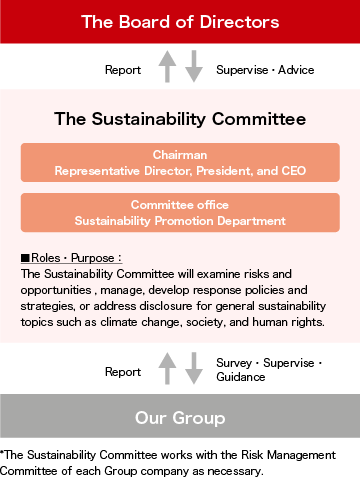
Governance
The Sustainability Committee, headed by Representative Director, President, and CEO, meets at least once a quarter in principle to discuss and manage risks and opportunities, formulate policies and strategies to address them, and report regularly to the Board of Directors on the status of these efforts. In addition, the Board of Directors supervises and advices the committee.

Risk management
Risk management related to sustainability, including climate change, is managed by the Sustainability Committee.
In addition, the Sustainability Committee provides guidance and supervision as necessary for risk management in cooperation with each group company and each company's Risk management committee.
Strategies
We have developed two scenarios of climate change risks and opportunities: a "1.5°C scenario" with increased transition risks and "4°C scenario" with increased physical risks for our business operations. In addition, we have examined the risks according to the classification of risks in the TCFD recommendations.
Premises
【Time frame】
Around 2030 (medium-term) / 2050 (long-term)
【Impact】
Consider the magnitude of the impact on human life and health, corporate value and brand, social credibility, business strategy, and profitability, by rating them on a 5-point scale in the table below.
| Risks and opportunities impact on the company and its operations | Image of qualitative impact |
|---|---|
| Impact on human life and health, corporate value and brand, social credibility, business strategy, and profitability | |
| 5 | Extreme impact (positive or negative) |
| 4 | High impact (positive or negative) |
| 3 | Moderate impact (positive or negative) |
| 2 | Low impact (positive or negative) |
| 1 | Minimum impact (positive or negative) |
【Scenario Overview】
| Scenario | Overview | Main external scenarios for reference |
|---|---|---|
| 1.5℃ scenario |
This is a scenario in which policies, regulations, and market changes are rapidly implemented to move toward 2050 carbon neutrality and limit the global average temperature increase to 1.5°C when compared to levels before the Industrial Revolution, increasing transition risks. |
|
| 4℃ scenario |
This is a scenario in which policies and regulations to reduce greenhouse gas emissions and social initiatives fail to make progress, which leads to a global average temperature increase of 4°C compared to levels before the Industrial Revolution, leading to more severe climate change impacts, such as disasters, and increasing physical risks. |
|
The table below shows the risks and opportunities associated with climate change that we have identified based on our review of assumptions.
■Examples of risks and opportunities on list are the results of these qualitative scenario analyses (Including those with small impacts)
| Transition risks and opportunities | Risk |
|
|---|---|---|
| Physical risks and opportunities | Risk |
|
■At some point in the medium to long term, items rated impact 4 or higher were identified as risks and opportunities that may have a large impact on the company in particular, as shown below, with details of the results of the review and the direction of the response.
| Risks and Opportunities | scenario | Impact by time frame | More about Risks and Opportunities | Direction of the response | |||
|---|---|---|---|---|---|---|---|
| Medium-term | Long-term | ||||||
| Physical risks and opportunities |
Interruption of power infrastructure due to natural disasters | Risks | 4℃ | 3 | 4 | Interruption of electric power infrastructure caused by natural disasters could result in business suspension and restoration of facilities. | To strengthen our business interruption risk response capabilities based on a business continuity plan (BCP) that considers the decentralization of operations to sites outside the disaster area. |
